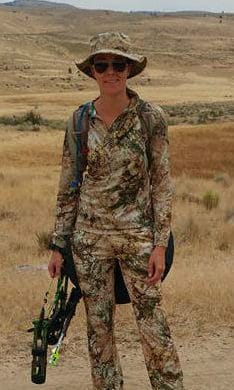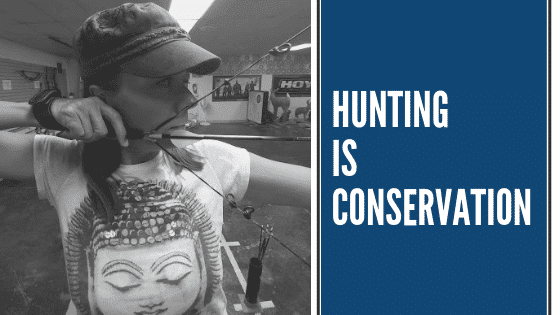I earn a small commission via affilate links at no extra cost to you.
I have a unique position. I have an Environmental Science degree and I’m also a bow hunter. Throw in my years working as a massage therapist and the bit of “woo” that comes with that and I don’t really fit into anyone’s box. Of course I’ve come across many different types of people. On one hand there is the “all hunting is pure death and murder” crowd. On the other hand there are the people who believe that “the only good wolf is a dead one.” I scratch my head at both because they are both wrong. For the second group I’ll suggest studying ecology, food webs, and the interactions of all species. To the death and murder crowd I’m going to show you how hunters are the true conservationists.
It’s a subject that you can’t just look at from the surface, you have to look at all of the components (much like a food web). Humans hunted bison, elk, and white tail deer to some pretty low numbers. However by recognizing that they could no longer hunt if they killed all of the animals a new era of conservation began.
-
In 1907, only 41,000 elk remained in North America, today there are more than 1 million.
-
In 1900, only 500,000 whitetails remained, today there are more than 32 million.
-
In 1900, only 100,000 wild turkeys remained. Thanks to hunters, today there are over 7 million.
-
In 1901, few ducks remained. Thanks to hunters’ efforts to restore and conserve wetlands, today there are more than 44 million.
-
In 1950, only 12,000 pronghorn remained, today there are more than 1.1 million.
-
With funding from hunters, the Rocky Mountain Elk Foundation (RMEF) helped restore wild elk herds in seven states and provinces. [1]
If hunters are truly the bad people some think that they are why have wildlife numbers increased so greatly? No one spends more on conservation than hunters do!
-
Through state licenses and fees, hunters pay $796 million a year for conservation programs.
-
Through donations to groups like RMEF, hunters add $440 million a year to conservation efforts.
-
In 1937, hunters actually requested an 11% tax on guns, ammo, bows and arrows to help fund conservation. That tax, so far, raised more than $11 billion for wildlife conservation.
-
An 11% tax on guns, ammo, bows and arrows generates $371 million a year for conservation.
-
All together, hunters pay more than $1.6 billion a year for conservation programs. No one gives more!
-
Every single day U.S. sportsmen contribute $8 million to conservation.
-
Habitat, research and wildlife law enforcement work, all paid for by hunters, help countless non-hunted species. [1]
Groups like RMEF purchase huge tracts of land for wildlife to live on. Once they own it it will never be developed. They’re putting aside pieces of nature so that nature can thrive as its supposed to. RMEF has 7 million plus acres of habitat conservation. To give you an idea of how much land that is, the Hawaiian Islands are roughly 7 million acres.
What’s It Like To Go Hunting?

If you think hunting is a free for all I have to laugh. I’ve been antelope hunting the last 3 years. Do you know how many antelope I’ve shot? ZERO. How many arrows have I shot at antelope? ZERO. Just because a person goes hiking with a weapon does not automatically mean they will kill an animal. Now factor in my husband’s work schedule and the mere 2 weeks my tag is in season; I’ll say that I’ve spent a little more than 2 weeks over the last 3 years antelope hunting.
Have I seen antelope? I’ve watched herds from hilltops and while hiding in the sage. When you’re bow hunting the animal has to be within 40 yards of you for a good shot. Out where the antelope live it’s flat and if they see you they take off running. From my experience they tend to run about 2 ridges away in a matter of seconds; there’s a reason they call them speed goats. The alternative is to sit near water and hope they show up. Antelope season is at the end of summer so where I hunt it’s in the mid 90’s, there is zero shade, and everything I touch is so dry that it crunches.
This year I tried my hand at hunting mule deer but in the few days I had I came up empty handed. What’s interesting is learning about each animal and their behaviors. Mule deer are less likely to run away like antelope do if they see you but if they smell you…they’re out of there. This is why you have to continuously be aware of the wind and how it’s moving. If you see deer on a hill you have to factor in the wind, where they’ll be able to see you, and the terrain and then figure out how you might be able to get closer. It’s definitely not a video game or a carnival game. This is where the experience of spending a lot of time in nature and reading the cues is a huge key to your success.
Female Hunters On The Rise
Female participation in hunting (3.35 million) is on the rise thanks to a 10% increase from 2008 to 2012. Young women are the fastest growing demographic of outdoor enthusiasts. For me, I became a bow hunter because I feel like it’s a way for me to walk my talk. As a Primal Health Coach who preaches ancestral health principles it simply felt right. Every supermarket is loaded with grain & hormone fed animals. To buy pasture raised animals the price is significantly higher because our government doesn’t subsidize grass. Picking up a bow and getting out there to fill my freezer is one of the ways I give the middle finger to our food system. There are more non-food options than there are real food options.
When I have those days when I spend too much time on social media and I suspect society / humanity is on the verge of collapse it’s reassuring to know that if I had to go get my own food I could. It may take me a bit but it’s reassuring to have the skills to feed myself.
Shooting a bow is also really fun. Back when my husband and I first met I shot a practice bow at a range just to see what it was like. Holy WOW! It was a feeling that stuck with me and I knew I’d come back to it someday. Even if/when my bow hunting days end I still see myself shooting in local events.
Wildlife Management
Hunters wouldn’t have been able to increase wildlife populations if hunting were the killing spree that some think it is. Rather, we employ wildlife biologists to determine how many hunting tags can be issued each season. There are some tags like Idaho Moose that are highly restrictive. If you enter the draw for a moose tag you can’t enter any other hunts that year. If you get a moose tag it’s the only one you’ll ever get whether you shoot an animal or not. There are different seasons for different weapons and different zones that generally have different rules. In some areas anyone who wants a tag can get one but in other areas it’s a lottery that you have to win to get a tag. Scientists look at the herds, where they roam, and the health of their population before deciding how many hunting tags are available.
If a wildlife species population becomes too large the animals can risk starvation and/or throw off the balance of the ecosystem / food web. Hunters manage both predators (bears, coyotes, cougars, and wolves) and prey (deer, elk, antelope, hogs, and moose); that in turn helps prevent species from going extinct because the food web is kept in check. There are rogue hunters that give hunters a bad name; these are the people who take animals without a hunting tag. They are the hunters that I don’t like being associated with; that’s not me. There’s a difference between being a hunter and a killer.
 The Best Reasons To Become A Hunter
The Best Reasons To Become A Hunter
- Today we’re more tied to our phones than we are to wildlife and conservation. We no longer have to out smart our dinner and in that sense we’ve lost our innate wisdom to survive outside of the modern world. I think we’re seeing how disconnected we are to nature by the enormous amount of plastic floating in our oceans. The people who pass on the hunting tradition will continue to be the future conservationists. Unless you’ve tried hunting there’s likely a lot of nature that you’re missing. As I hide in the sage I get to watch the activity of all the insects. Then suddenly they all seem to disappear and I instinctively know that the big cloud in the sky is most likely going to bring rain. When you’re stalking animals you get a sense of their personality and what they’ll put up with before running off. Ultimately, I think it’s the highest form of immersion in nature that you can get.
- The world’s most organic, lean, free-range meat. As I said before, hunting is my way of giving the middle finger to our modern day food system. We raise unhappy animals in deplorable conditions and feed them an unnatural diet just so we can fatten our wallets.

Originally posted on April 3, 2019 @ 12:27





